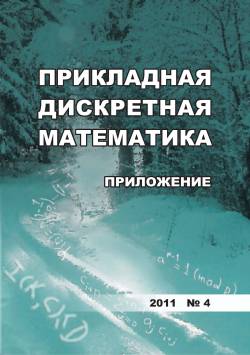Equivalence of primitive sets
Equivalence of primitive sets of natural numbers is investigated in connection with the diophantine Frobenius problem. The equivalence is used to simplify calculations of Frobenius number g(aq,..., a k) and all numbers that are not contained in the additive semigroup generated by the set {ai,..., afc}.
Download file
Counter downloads: 321
Keywords
функция Фробениуса, примитивное множество, аддитивная полугруппа чисел, Frobenius's function, primitive set, additive semigroups of numbersAuthors
| Name | Organization | |
| Fomichev V. M. | Financial University under the Government of the Russian Federation (Moscow) | fomichev@nm.ru |
References
Sylvester J. J. Problem 7382 // Mathematical Questions from the Educational Times. 1884. V. 37. P. 26.
Alfonsin J. R. The Diophantine Frobenius problem. Oxford University Press, 2005.
Фомичев В. М. Решение диофантовой проблемы Фробениуса // Дискретная математика. 2013. №2.
Curtis F. On formulas for the Frobenius number of a numerical semigroup // Math. Scand. 1990. V. 67. P. 190-192.
Heap B. R. and Lynn M. S. A graph-theoretic algorithm for the solution of a linear diophantine problem of Frobenius // Numerische Math. 1964. No. 6. P. 346-354.
Heap B. R.and Lynn M.S. On a linear diophantine problem of Frobenius: an improved algorithm. // Numerische Math. 1965. No. 7. P. 226-231.
Bogart C. Calculating Frobenius numbers with Boolean Toeplitz matrix multiplication // For Dr. Cull, CS 523, March 17, 2009. Oregon State University.
Nijenhuis M. A minimal-path algorithm for the "money changing problem" // The American Mathematical Monthly. 1979. V. 86. P. 832-835.
Bocker S. and Liptak Z. The "money changing problem" revisited: computing the Frobenius number in time O(ka1). Technical Report No.2004-2, Univ. of Bielefeld, Technical Faculty, 2004.
